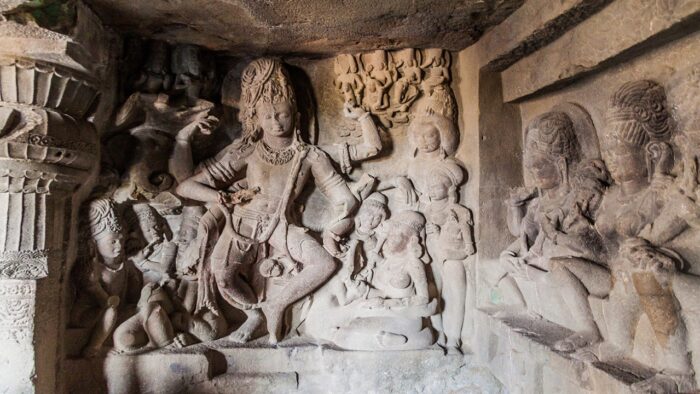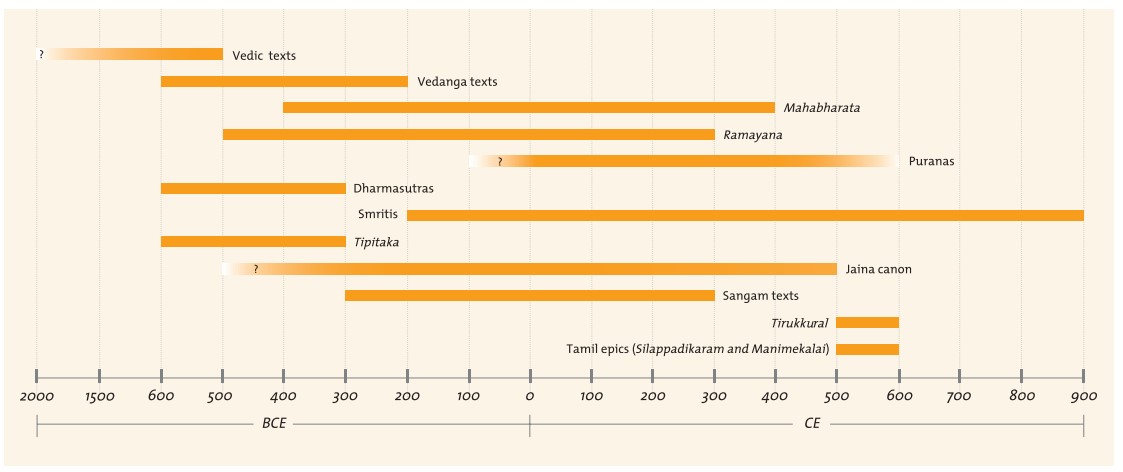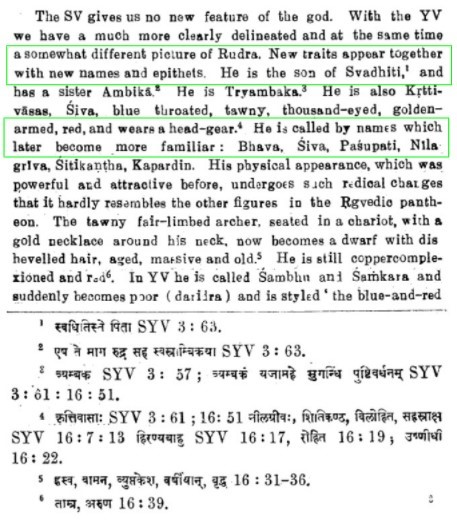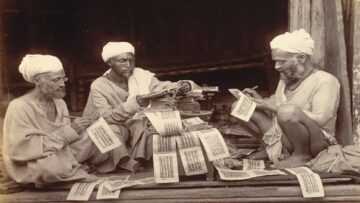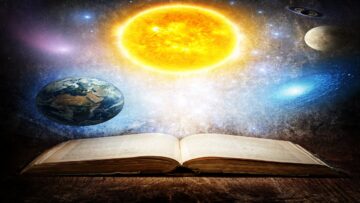Abstract
Is the term Śiva, as a noun, attested only in the itihāsa-s and purāṇa-s, and therefore, in existence supposedly only after around 500 BCE? Was Śiva a minor, non-supreme, figure in the text corpus indigenous to the Indian subcontinent before Śvetāśvataropaniṣad? Does clear and reliable evidence for organized sectarian worship of Śiva exist only after the beginning of the common era? If you were to look for answers to these questions in the entry for “Shaivism” in the Oxford Bibliographies—which sports a tagline “Your best research starts here”—or Wikipedia, you will find either answers or sources to answers, in the near affirmative, to all questions above. This paper will foreground evidence that problematizes answers in the affirmative to the above-mentioned questions. It will do so, in part, by foregrounding evidence about Śiva from Aṣṭādaśavidyā texts that appear missing in at least those essays considered “up-to-date introductions on the historical development of the Shaiva sectarian traditions” by Peter Bisschop, the author of the entry for “Shaivism” in the Oxford Bibliographies.
I. Preliminaries
This paper comprises three sections: Preliminaries, Analysis, and Conclusion. In this section, which is Preliminaries, I will include points that should further enhance the fidelity of the abstract. Essays Peter Bisschop—author of the entry for “Shaivism”[1] in the Oxford Bibliographies—refers to as “up-to-date introductions on the historical development of the Shaiva sectarian traditions”[2] are Śaivism: An Overview authored by Lorenzen et al. (1987) in The Encyclopedia of Religion and The Śaiva Traditions by Gavin Flood (2003) in The Blackwell Companion to Hinduism. Aṣṭādaśavidyā[3] in the abstract refers to one system of Indic knowledge described in the viṣṇu purāṇa[4]. By the term Indic, used in the previous sentence, I roughly mean “of or relating to the Indian subcontinent”[5] but do not imply only “of, relating to, or constituting the Indo-Aryan branch of the Indo-European languages”[6]. Finally, sentences that are alluded to as “near affirmative” answers to the questions in the abstract are the following:
Excerpt 1: “The term evolved from the Vedic Rudra-Shiva to the noun Shiva in the Epics and the Puranas, as an auspicious deity who is the “creator, reproducer and dissolver.”[7] [Emphasis mine]
Excerpt 2: “But it is only with the Śvetāśvatara Upaniṣad, …, that a theism focused upon Rudra-Śiva begins to emerge in the literature. … . Here Rudra is elevated from the feral deity on the edges of society to the status of the supreme being as the cause of the cosmos, the magician (māyin) who produces the world through his power (śakti), yet who transcends his creation.” (Flood 2003:205) [Emphasis mine]
Excerpt 3: “The god Rudra-Śiva appears for the first time as the object of monotheistic devotion rather suddenly in the Śvetāśvatara Upaniṣad, a text often described as a Śaiva Bhagavadgītā. The Śvetāśvatara is one of the later of the early Upaniṣads, possibly dating from about the sixth century BCE, and clearly illustrates how these texts mark the historical transition from Vedism to Hinduism.” (Lorenzen 2005:8040) [Emphasis mine]
Excerpt 4: “The roots of early Shaivism can be traced back to the worship of the Vedic deity Rudra, but it is only in the centuries after the start of the Common Era that there is clear and reliable evidence for the existence of organized sectarian worship of Rudra-Shiva, with the appearance of the Pāśupatas, or “followers of Paśupati.””[8] (Bisschop 2011)
II. Analysis
II.1: Related to the antiquity of the usage of Śiva as a noun
“Epics and the Puranas” is mentioned in excerpt 1 as the source of the usage of “Shiva” as a noun. The source link of excerpt 1 (foot note 7) does not allude to the chronological epoch of “Epics and the Puranas.” Yet, I have added “500 BCE” in question 1 of the abstract, in part, because of the epochs assigned to the Rāmāyaṇa (500 BCE – 300 CE), the Mahābhārata (400 BCE – 400 CE), and the “Puranas” (~100 BCE (with a ?) – ~600 CE) in Figure 1.1 of Upinder Singh’s book A History of Ancient and Early Medieval India:
Figure 1: Figure 1.1 in (Singh 2016:15) [9]
According to the image above, “Vedic texts” are assigned an epoch ending at 500 BCE. Later, in the same book, Singh has written:
“Historians divide the Vedic corpus into two parts—early and later Vedic texts, although recent studies indicate a more complex internal chronology. Early Vedic literature refers to the family books of the Rig Veda Samhita. Later Vedic literature includes Books 1, 8, 9, and 10 of the Rig Veda Samhita, the Samhitas of the Sama, Yajur, and Atharva Vedas, and the Brahmanas, Aranyakas, and Upanishads attached to all the four Vedas. (Among these later texts, the Mantra portions are the earliest, followed by the Brahmanas, Aranyakas, and Upanishads.) The cultural stages reflected in the two broad strata of early and later Vedic texts have come to be known as the early and the later Vedic cultures. The principal Shrautasutras and some of the early Grihyasutras have been dated c. 800–400 BC.” (Singh 2016:187) [Emphasis mine]
Given all of the above, it follows that if one finds evidence for the usage of Śiva as a noun in a Veda Saṃhitā or an early Gṛhyasūtra, then the assertion in excerpt 1 is at least partially, if not wholly, invalidated.
Now consider the following evidence. In a paper published in 1960, Sukumari Bhattacharji[10] has alluded to the usage of Śiva as a name in śuklayajurveda (SYV) 16:51, which begins with the following: मीढुष्टम शिवतम शिवो नः सुमना भव[11] (mīḍhuṣṭama śivatama śivo naḥ sumanā bhava):
Figure 2: Excerpt from Sukumari Bhattacharji (1960) page 86 [12]
After his translation of Vājasaneyī Saṃhitā 16.41 {नमः शम्भवाय च मयोभवाय च नमः शंकराय च मयस्कराय च नमः शिवाय च शिवतराय च[13] (namaḥ śambhavāya ca mayobhavāya ca namaḥ śaṃkarāya ca mayaskarāya ca namaḥ śivāya ca śivatarāya ca)}, RL Kashyap has made it a point to remark thus: “Here is the famous five-lettered mantra … to Shiva: ‘namaḥ shivāya’.” (Kashyap [2012] 2020:279).
Moving on now, from the pre-500 BCE Veda Saṃhitā seen above (the Vājasaneyī Saṃhitā) to evidence for the usage of Śiva as a name in an early (pre-500 BCE) Gṛhyasūtra, the Āśvalāyanagṛhyasūtra, and in it, 4.8.19:
“Harāya.mṛdāya.śarvāya.śivāya.bhavāya.mahā.devāya.ugrāya.bhīmāya.paśu.pataye.rudrāya.śaṃkarāya.īśānāya.svāhā.iti.”[14] [Emphasis mine]
II.2: Rudra-Śiva as Supreme before Śvetāśvatara Upaniṣad
Excerpts 2 (from Flood) and 3 (from Lorenzen) listed in the Preliminaries, when read together, yield an impression that before the Śvetāśvatara Upaniṣad (sixth century BCE according to Lorenzen), there is no textual evidence that Rudra-Śiva was considered Supreme. In response to this view, I will cite an argument put forth by Sri Aurobindo and textual evidence presented by Ramakrishna Gopal Bhandarkar and Mahadev Chakravarti:
“It was a view long popularised by European scholars that the greatness of Viṣhnu and Shiva in the Purāṇic theogonies was a later development and that in the Veda these gods have quite a minor position and are inferior to Indra and Agni. … The importance of Vedic gods has not to be measured by the number of hymns devoted to them or by the extent to which they are invoked in the thought of the Riṣhīs, but by the functions which they perform. Agni and Indra to whom the majority of the Vedic hymns are addressed, are not greater than Viṣhnu and Rudra, but the functions which they fulfil in the internal and external world were the most active, dominant, and directly effective for the psychological discipline of the ancient Mystics; this alone is the reason of their predominance. The Maruts, children of Rudra, are not divinities superior to their fierce and mighty Father; but they have many hymns addressed to them and are far more constantly mentioned in connection with other gods, because the function they fulfilled was of a constant and immediate importance in the Vedic discipline. On the other hand, Viṣhnu, Rudra, Brahmaṇaspati, …, provide the conditions of Vedic work and assist it from behind the more present and active gods, but are less close to it and in appearance less continually concerned in its daily movements.” (Sri Aurobindo’s words from The Secret of the Veda cited in Kashyap [2003] 2021:16-7) [Emphasis mine]
“By his power he perceives all earthly beings and by his universal sovereignty he perceives divine beings (RV. VII. 46.2). Here even in the Ṛgveda, Rudra is raised to supreme power.” (Bhandarkar 1913:103) [Emphasis mine]
“…he now becomes the lord of all quarters[79]—of forests and fields, of trees and plants, of food and moving creatures. Herein lies the reason which rendered him in later times the omnipresent supreme lord of the universe.[80]” (Chakravarti [1986] 2002:7) [Emphasis mine]
The footnote [79] in Chakravarti ([1986] 2002:7) points to Vājasaneyī Saṃhitā 16:18 which contains “जगतां पतये”:
नमो बभ्लुशाय व्याधिने अन्नानां पतये नमो नमो भवस्य हेत्यै जगतां पतये नमो नमो रुद्रायाततायिने क्षेत्राणां पतये नमो नमः सूतायाहन्त्यै वनानां पतये नमः (Kashyap [2012] 2020:268) [Emphasis mine]
“RV. VII. 46.2,” which Bhandarkar invokes to make the point that Rudra has already been raised to “supreme power,” is the following:
स हि क्षयेण क्षम्यस्य जन्मनः साम्राज्येन दिव्यस्य चेतति ।
अवन् अवन्ती: उप नो दुर: चर अनमीवो रुद्र जासु नो भव ॥ (Kashyap [2007] 2016:167)
I posit thanks to this pointer[15] that “त्र्यम्बकं यजामहे” (Kashyap [2007] 2016:202)[16] in Ṛgveda Sūkta 7.59.12 also bespeaks Supreme.
II.3: Evidence of organized sectarian worship of Śiva before the common era
Excerpt 4 in the Preliminaries, which is from the Oxford Bibliographies entry for “Shaivism,”[17] asserts that “…it is only in the centuries after the start of the Common Era that there is clear and reliable evidence for the existence of organized sectarian worship of Rudra-Shiva.”[18] This assertion, in my view, is untenable, or at least problematic, in light of 2.4.17 of the अर्थशास्त्र (Arthaśāstra):
अपराजिताप्रतिहतजयन्तवैजयन्तकोष्ठान् शिववैश्रवणाश्विश्रीमदिरागृहाणि च पुरमध्ये कारयेत् (Kangle 1960:39) [Emphasis mine]
“He should cause to be built in the centre of the city shrines for Aparājita, Apratihata, Jayanta and Vaijayanta as well as temples for Śiva, Vaiṣravaṇa, Aśvins, Śrī and Madirā” (Kangle 1963:80) [Emphasis mine]
“In the middle of the city,* he should have these built: shrines for Aparājita, Apratihata, Jayanta and Vaijayanta, and abodes for Śiva, Vaiṣravaṇa, Aśvins, Śrī and Madirā.” (Olivelle 2013:106) [Emphasis mine]
Even the recently published revisionist views of Mark McClish, on the history (and the chronology) of the Arthaśāstra cannot help Bisschop’s case as even McClish’s hypothesis does not push the reference cited above (2.4.17) to the common era. 2.4 is part of what McClish has called “the original treatise” (McClish 2019:137), the sources of which were, even as per McClish,[19] before the common era. If there is such unambiguous evidence for temples or abodes themselves for Śiva, that too right in the middle of the city, how can it be claimed that organized sectarian worship started only after the common era? It is also worth pointing out that for reasons not at all clear to me, this evidence from the Arthaśāstra rarely, if ever, gets mentioned in analyses related to the early history of Śaivism. In the Oxford Bibliographies entry for “Shaivism,” the articles referred to as “…accessible up-to-date introductions on the historical development of the Shaiva sectarian traditions…” don’t mention the Arthaśāstra even once.
III. Conclusion
Unless engaged with and shown to be untenable, and until that happens, this paper, by critically engaging, insofar I could see, for the first time, with three sweeping conclusions about the early history of Śaivism as found attested in contemporary academic literature concerned with Śaivism, puts forth a unique contribution. In II.1, based on textual evidence from the Vājasaneyī Saṃhitā and the Āśvalāyana Gṛhyasūtra, I posit that there is evidence for the usage of Śiva as a noun from before 500 BCE. In II.2, I have foregrounded an explanation by Sri Aurobindo and textual evidence presented by Ramakrishna Gopal Bhandarkar and Mahadev Chakravarti, from the Ṛgveda and the Vājasaneyī Saṃhitā respectively, which problematize the view that Rudra-Śiva became Supreme only in and after the Śvetāśvatara Upaniṣad. In II.3, I have invoked unambiguous evidence from the Arthaśāstra to present what seems like a rarely made case, if at all made before (in the literature dealing with Śaivism), of worship of Śiva in temples/abodes before the common era.
Bibliography
Bhandarkar, R.G. 1913. VAIṢṆAVISM ŚAIVISM and MINOR RELIGIOUS SYSTEMS. Varanasi: Indological Book House.
Bhattacharji, Sukumari. 1960. “RUDRA from the VEDAS to the MAHĀBHĀRATA.” Annals of the Bhandarkar Oriental Research Institute 41 (1/4): 85–128. http://www.jstor.org/stable/44028447.
Bisschop, Peter. 2011. “Shaivism.” Oxford Bibliographies. Oxford University Press. January 27, 2011. https://www.oxfordbibliographies.com/view/document/obo-9780195399318/obo-9780195399318-0051.xml.
Chakravarti, Mahadev. (1986) 2002. The Concept of Rudra-Śiva through the Ages. Delhi: Motilal Banarasidass Publishers.
Flood, Gavin. 2003. “The Śaiva Traditions.” In The Blackwell Companion to Hinduism, edited by Gavin Flood, 200–228. Malden/Oxford: Blackwell.
Kalyanasundaram, Megh. 2020a. “An Analysis of Some Aspects of ‘Chronology’ in ‘the Early Upaniṣads’ and Some Observations of Consequence to the Global History of Philosophy before C. 500 BCE.” Academia, August. https://www.academia.edu/43761472/An_analysis_of_some_aspects_of_Chronology_in_The_Early_Upani%E1%B9%A3ads_and_some_observations_of_consequence_to_the_Global_History_of_Philosophy_before_c_500_BCE.
———. 2020b. “‘India That Is Bharat…: One Country, Two Names’ and ‘the Concept of Bhāratavarṣa and Its Historiographical Implications’: A Response.” Academia, December. https://www.academia.edu/45303222/_India_that_is_Bharat_One_Country_Two_Names_and_The_Concept_of_Bh%C4%81ratavar%E1%B9%A3a_and_Its_Historiographical_implications_A_response.
Kangle, R.P. 1960a. The Kauṭilīya Arthaśāstra Part I. 1st ed. Bombay (now Mumbai): University of Bombay.
———. 1960b. The Kauṭilīya Arthaśāstra Part I. 1st ed. Bombay (now Mumbai): University of Bombay.
Kashyap, R.L. (2007) 2016. Rig Veda Samhitā Maṇḍala – 7. 1st ed. Bangalore: Sri Aurobindo Kapāli Sāstry Institute of Vedic Culture.
———. (2012) 2020. Yajur Veda Vājasaneyi Samhitā. 1st ed. Vol. I. Bangalore: Sri Aurobindo Kapāli Sāstry Institute of Vedic Culture.
———. (2003) 2021. Rudra Mantras from the Taittirīya Samhitā. 2nd ed. Bangalore: Sri Aurobindo Kapāli Sāstry Institute of Vedic Culture.
Lorenzen, David N. 2005. “ŚAIVISM: AN OVERVIEW.” In Encyclopedia of Religion (Second Edition) Vol. 12, edited by Lindsay Jones, 8038–42. Farmington: McMillan.
McClish, Mark. 2019. The History of the Arthaśāstra: Sovereignty and Sacred Law in Ancient India. 1st ed. Cambridge: Cambridge University Press.
Olivelle, Patrick. 1998. THE EARLY UPANIṢADS: Annotated Text and Translation. New York, Oxford: Oxford University Press.
———. 2013. King, Governance, and Law in Ancient India : Kauṭilya’s Arthaśāstra. New Delhi: Oxford University Press.
Singh, Upinder. 2016. A History of Ancient and Early Medieval India : From the Stone Age to the 12th Century. Noida, India: Pearson.
Upreti, Thaneshachandra. 2005. VIṢṆUMAHĀPURĀṆAM of MAHARṢI VEDAVYĀSA with Sanskrit Commentary of “ĀTMAPRAKĀŚA” of ŚRĪDHARĀCĀRYA. Edited by Thaneshachandra Upreti. 2nd ed. Vol. I. New Delhi: Parimal Publications. https://archive.org/details/vp_vol1/page/n465/mode/2up.
[1] https://www.oxfordbibliographies.com/view/document/obo-9780195399318/obo-9780195399318-0051.xml Accessed on Feb 19, 2022
[2] Ibid.
[3] aṣṭādaśa:18, vidyā: Knowledge. The 18 are: 4 veda-s {ṛg, yajur, sāma, atharva}, 6 vedāṅga-s {śikṣā, kalpa, vyākaraṇa, jyotiṣa, chanda, nirukta}, 4 upāṅga-s {mīmāṃsa, nyāya, purāṇaṃ, dharmaśāstra} and 4 upaveda-s {āyurveda, dhanurveda, gāndharvaveda, arthaśāstraṃ}.
[4] अङ्गानि चतुरो वेदा मीमांसा न्यायविस्तरः। पुराणं धर्मशास्त्रञ्च विद्या ह्येताश्चतुर्दश।।२८॥
आयुर्वेदो धनुर्वेदो गान्धर्वश्चैव ते त्रयः। अर्थशास्त्रं चतुर्थन्तु विद्या ह्यष्टादशैव ताः॥२९॥ (Upreti, 2005, p. 352)
The dating of viṣṇu purāṇa appears to be a matter of unsettled academic debate. The entire corpus of purāṇa-s have been dated to a period “after the last few centuries BCE” (Olivelle, 1998, p.13). This view posited by Olivelle has been recently analysed (see Kalyanasundaram, 2020a, pp. 2-5) and demonstrated to be, at the very least, highly problematic.
[5] https://www.merriam-webster.com/dictionary/Indic Accessed on Feb 19, 2022. To be more specific, the geography implied by the word Indic, for me, is the outline of the shape of the space that emerges from the description of Bhāratavarṣa in 63 contiguous verses (see verses 06010005a to 06010068c in Kalyanasundaram, 2020b, pp. 6-8) of the critical edition of the Mahābhārata.
[6] https://www.merriam-webster.com/dictionary/Indic Accessed on Feb 19, 2022. My interpretation of Indic includes Tamizh, as much as it does Sanskrit, and other languages.
[7] https://en.wikipedia.org/wiki/Shaivism#:~:text=Shaivism%20 Accessed on Feb 19, 2022
[8] https://www.oxfordbibliographies.com/view/document/obo-9780195399318/obo-9780195399318-0051.xml Accessed on Feb 19, 2022
[9] Figure 1.1 THE PERIOD OF COMPOSITION OF SOME IMPORTANT ANCIENT INDIAN TEXTS Singh 2016:15)
[10] https://www.jstor.org/stable/44028447 Accessed on Feb 19, 2022
[11] (Kashyap [2012] 2020:283); Yajur Veda Vājasaneyi Samhitā Part I
[12] (Bhattacharji 1960:86)
[13] (Kashyap [2012] 2020:279); Yajur Veda Vājasaneyi Samhitā Part I
[14] http://gretil.sub.uni-goettingen.de/gretil/1_sanskr/1_veda/5_vedang/2_grhya/asvgs_u.htm Accessed on Feb 19, 2022.
[15] “See also (7.59.12) dealing with Shiva as Trayambaka…” (Kashyap [2007] 2016:167)
[16] Kashyap’s translation of त्र्यम्बकं यजामहे: “We adore the Father of the three worlds,…” (Kashyap [2007] 2016:202)
[17] “Shaivism” by Peter Bisschop. For Oxford Bibliographies. https://www.oxfordbibliographies.com/view/document/obo-9780195399318/obo-9780195399318-0051.xml Accessed on Feb 19, 2022.
[18] Ibid.
[19] “Sometime around the first century BCE, an unknown expert on government drew together a number of disparate sources pertaining to statecraft, added some of his own material, and forged them into a comprehensive treatise.” (McClish 2019:152)
Feature Image Credit : istockphoto.com
Watch video presentation of the above paper here:
Disclaimer: The opinions expressed in this article belong to the author. Indic Today is neither responsible nor liable for the accuracy, completeness, suitability, or validity of any information in the article.

